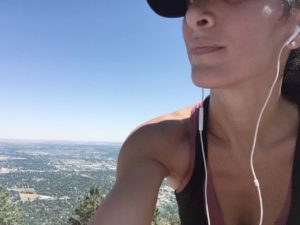
So what can you do that feels good and how much is enough?
How much is too much?
The truth is, that adrenal function during recovery is tapped. Chances are, you may have been slowly battling adrenal burnout well before chronic illness. If we are not careful, we can tap adrenals out even more with exercise during recovery; however, we want to stimulate our oxygen levels, and get our red blood cells moving, so that we are strong enough to fight infection. Oxygen, believe it or not through circulation is vital for the healing process and for resistance to infection. Especially the pockets in our body, that don’t even receive much oxygen, like our joints, which coincidentally is where Lyme bacteria love to hang out. Mitochondrial function, the powerhouse of our itty bitty cells, are crucial to fighting chronic illness, that when this starts to malfunction, our energy production goes way down and we are left with excess fatigue and a weakened immune system. Both oxygen and mitochondrial function are fueled by exercise. So where is the balance? Too much exercise will tap out our adrenals even more and too little or no exercise will not fuel our pretty little cells to get us back up and running.
Here are a few beginner functions to start with, no matter what level you are in recovery. Some, so unfortunately, are bed ridden or in a wheelchair. Some, are getting out of bed now and some can actually get in the car and go to work. Wherever you are, you can always dial into something that works for you for that day. The trick is, to stay consistent and do something everyday unless you overdid it the day before and need the rest to recover:
- Deep Breathing – Yes, this is an old and redundant piece of advice. But it doesn’t mean it doesn’t work. Breathing, as you know, increases oxygen; and as I mentioned, oxygen is part of the battle in recovery. Brain fog can almost diminish with an hour of deep breathing and especially yoga, but start here first (you will get to yoga later) with legs crossed on the floor and your back against the wall for support if you need it. If not, keep your spine straight tummy tucked and close your eyes. I like to put a hand on my stomach and one on my heart for connection and gathering my thoughts. I can also visualize and feel all the oxygen getting circulated into each area of my body. Start with a 1-2-3 count inhale and a 1-2-3 count exhale for five breaths. When you’re inhaling, your tummy should be expanding, when you’re exhaling, your tummy should be concaving tightly inwards. Work your way up to a 6 or 8 count and increase the time to 10 minutes. Perhaps you can complete 10-15 breath cycles and see how you feel. The other benefits to doing this first thing in the morning is calming the mind and easing stress for the day. Not a bad side effect. The other ‘side effect’ is how this can literally massage your organs are so in need for TLC. Since Lyme or any inflammation causes tissue to become wounded or inflamed, we want to really find ways to internally massage and nurture our insides.
- Rebounding: Your lymphatic system needs help. And lots of those suffering have sluggish detoxification systems. I still do. Which is why later when you are WELL – you will do all sorts of exercise to flush out toxins and bacteria. Start with a light bounce to stimulate lymph and work up to 10-15 minutes a day. I used to put on my headphones with some great music and really get into this. It’s funny, you feel like a little kid but I sometimes think that’s half the point of a trampoline here. Just let it take you, bounce a way, look outside, think of all things you’re getting rid of and flushing out. You will be ridding more toxic waste, dead cells and trapped proteins and sluggish material up to 15-20 times more than usual using a rebounder. Ultimately, work your way up to 40 minutes a day. You can get fancy on a rebounder with different kicks and higher jumps.
- Nature Walking/Grounding: It’s simple, getting outdoors away form your home where all of your supplements, contraptions and research are waiting for you, will revive you, even for 15 minutes a day. With any luck, you will also have some sunshine for a bit of Vitamin D to revitalize your spirit and your hormone levels. Try to use this time in saying you are getting better here during this time with each step and breath, heeding you in the right direction. Find a flat course or a loop, try and explore. I lived alone in Manhattan. People thought I was nuts (I did too!) in finding a dog companion for myself, because I could barely see straight and take care of my own health. But he was the catalyst in my healing and recovery. He forced me out. If you don’t have a partner or friend or children to care for, sometimes this can inhibit you to force yourself to get outside and also to get well. But you are worth getting well and worth having a companion (of any sort!).
- Creative Movement or Dance: Ladies – this is where life can feel a little sexy when you are NOT feeling sexy. I used to take two-hour dance classes twice a week climbing up and down a pole with floor work that left me with bruises for days and I loved it – then I had to quit after 6 years. It feels as if you lose a part of yourself when you have to let go of something that you love. So I forced myself to do a little bit in my home. I did find a love eventually for floor work alone and for any type of dance that let me get out of my head. Find some great music that makes you feel good. Happy. Sad. Sexy. Sultry. Wild. Whatever speaks to you. Getting angry also works – whatever it is that needs to be released that day. Start slowly on the floor, roll your neck slowwwwwwly around, move your hands, your torso in circles in one direction and then the other, circle your hips or any movement that feels good. Stay on the floor if you need. Or stand in straddle for the whole time with your head upside down swaying side to side, letting blood rush in to your eyes, your brain. Anything that unites your body with music and its tempo. Complete one song, and then maybe two. Movement and dance is proven to ignite your fire, revitalize, express and renew confidence and address physical, emotional challenges when dealing with ANY disease, including cancer. I will be posting video clips for you to try, soon!
The trick is with any of these exercises to do one at a time each day and start with 5 minutes a day. If you feel ok or even better, than stick with 5 minutes the next day and the next. Increase the time by no more than 5 minutes the following week. If you feel WORSE, drop it back down. You will eventually be able to increase your activity. I will be the first to admit that I wanted to force everything. And still do sometimes, and I am really well now, but my adrenals will never fully be the same and so you have to take care and be careful and also kind to yourself. Listen to your body. When you need rest – rest. But try again tomorrow. In a few weeks or months, maybe you can work in 30 minute intervals or a full class, or a light jog during your walk.
I was in a place where I couldn’t do much at all. Now, I can pull a 60-90 minute workouts with cardio and weights, dance class, yoga class 3-5 times a week and even a 3-day workshop with the beautiful (and oh my, challenging) Marlo Fisken. This took me five years to get here, but I know you can do this too.
Here are a few links to rebounding, breathing and meditation movement (to come!).
References:

